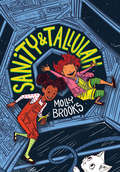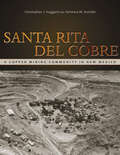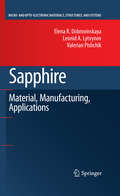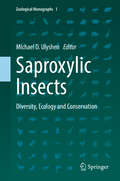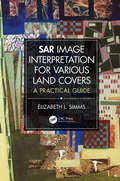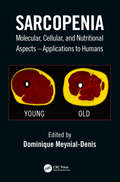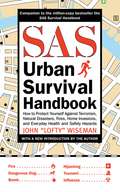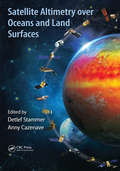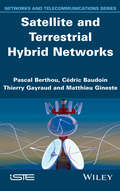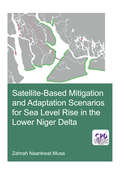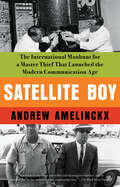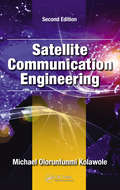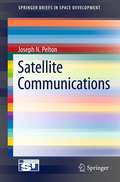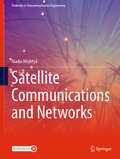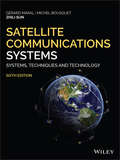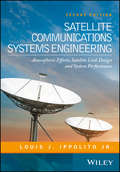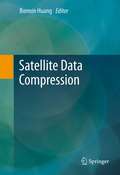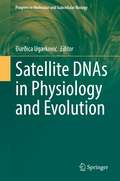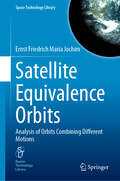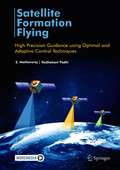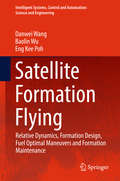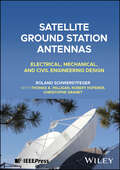- Table View
- List View
Sanity & Tallulah (Sanity & Tallulah #1)
by Molly BrooksSanity Jones and Tallulah Vega are best friends on Wilnick, the dilapidated space station they call home at the end of the galaxy. So naturally, when gifted scientist Sanity uses her lab skills and energy allowance to create a definitely-illegal-but-impossibly-cute three-headed kitten, she has to show Tallulah. But Princess, Sparkle, Destroyer of Worlds is a bit of a handful, and it isn't long before the kitten escapes to wreak havoc on the space station. The girls will have to turn Wilnick upside down to find her, but not before causing the whole place to evacuate! Can they save their home before it's too late?Readers will be over the moon for this rollicking space adventure by debut author Molly Brooks.
Santa Rita del Cobre: A Copper Mining Community in New Mexico (Mining the American West)
by Christopher J. Huggard Terrence M. HumbleAn account of the rise and fall of a mining town over two centuries, including photos: &“An excellent story of the people and their community.&” ―New Mexico Historical ReviewThe Spanish, Mexicans, and Americans, successively, mined copper for more than two hundred years in Santa Rita, New Mexico. Starting in 1799 after an Apache man led the Spanish to the native copper deposits, miners at the site followed industry developments in the nineteenth century to create a network of underground mines. In the early twentieth century these works became part of the Chino Copper Company&’s open-pit mining operations—operations that would overtake Santa Rita by 1970. In Santa Rita del Cobre, Christopher Huggard and Terrence Humble detail these developments with in-depth explanations of mining technology, and describe the effects on and consequences for the workers, the community, and the natural environment. Originally known as El Cobre, the mining-military camp of Santa Rita del Cobre ultimately became the company town of Santa Rita, which after World War II evolved into an independent community. From the town&’s beginnings to its demise, its mixed-heritage inhabitants from Mexico and the United States cultivated rich family, educational, religious, social, and labor traditions. Extensive archival photographs, many taken by officials of the Kennecott Copper Corporation, accompany the text, providing an important visual and historical record of a town swallowed up by the industry that created it.
Santiago's Silver Mine
by Eleanor ClymerJoin Andreas and Santiago on an exciting adventure and search for treasure near the small mexican farming village where they live. Learn about mexican customs and the rich history of the land.
Sanwad: संवाद
by Achyut Godboleमनुष्य हा समाजप्रिय प्राणी आहे, म्हणूनच इतिहासात डोकावून बघितलं तर आदिम काळापासून मनुष्य समूहानं किंवा टोळ्यांनी राहत असलेला बघायला मिळतो. अगदी सुरुवातीला माणलानं एकमेकांशी संवाद कसा साधला असेल? या प्रश्नाच्या कुतूहलातूनच अच्युत गोडबोले यांचं ‘संवाद’ हे पुस्तक लिहिलं गेलं आहे. ‘संवाद’ या पुस्तकात चित्रलिपीद्वार, खाणाखुणा करून, वेगवेगळे आवाज करुन आदिमानवाच्या परस्परांतल्या संवादाला कशी सुरुवात झाली याचा इतिहास तर आहेच, पण त्याचबरोबर शेतीमुळे स्थैर्य आल्यानंतर माणसाच्या जगण्यात जे बदल झाले, त्यातच त्यानं लावलेला छपाईयंत्राचा शोध असेल किंवा टपालव्यवस्थेचा शोध असेल, या सगळ्या शोधांनी माणसं एकमेकांशी कसा संवाद साधायसा लागली, त्यातून काय गमतीजमती घडत गेल्या, या शोधकर्त्यांना कुठकुठल्या अडचणींना तोंड देत आपल्या ध्येयापर्यंत पोहोचावं लागलं, त्या त्या काळात तंत्रज्ञान कसं बदलत गेलं, तंत्रज्ञानानं माणसाच्या संवादात काय बदल घडवून आणले, या प्रवासात किती तंत्रज्ञांचा मृत्यू अत्यंत हलाखीत झाळा आणि किती जणांचं आयुष्य प्रचंड वैभवात गेलं, हे सगळं या पुस्तकात बाचकांची उत्कंठा वाढवणार आहे. त्याचबरोबर प्रत्येक शोधाचा शोधकर्ता, त्या शोधामागचं तंत्रज्ञानदेखील ‘संवाद’मध्ये अतिशय सोप्या भाषेत उलगडून दाखवण्याचा प्रयत्न केला आहे. आदिमानवापासून व्हॉट्सअपच्या युगापर्यंत माणसानं एकमेकांशी संवाद कसा साधला याविषयीची एक रंजक आणि चित्तथरारक कहाणी म्हणजे ‘संवाद’! यामध्ये शिंग, तुतारी, आगीपासून ते भाषेचा आणि लिपीचा उगम, कागद आणि छपाई यांचे शोध, टपालव्यवस्था, वर्तमानपत्र, मोबाइल फोन, फेसबुक आणि व्हॉट्सअप या सर्वांच्या जीवघेण्या स्पर्धात्मक जन्मकथा आपल्याला ‘संवाद’मध्ये खिळवून ठेवतील.
Sapphire
by Elena R. Dobrovinskaya Leonid A. Lytvynov Valerian PishchikThis book provides encyclopedic coverage of sapphire: growth and fabrication, high quality material, and numerous practical applications. Some of the fields of application include, but are not limited to, quantum electronics, radio electronics, radio engineering, radiolocation, ultrahigh resolution optics, high temperature optics, aircraft, atomic power engineering, space, space and microwave engineering. Unusual, versatile and attractive physical and chemical properties of sapphire will be addressed, as well as the main trends in the evolution of the growth methods. Important features of the book include the following: Addresses for the first time in a convenient and readily accessible format information on physical, chemical, mechanical and other properties of sapphire Provides users with the up-to-date information of the potential that sapphire provides in the different fields of engineering and applied science, including the areas of micro- and opto-electronics Summarizes the most important modern growth methods, mechanical and thermal treatment, and fabrication of sapphire products Provides recommendations for the best method of growing sapphire with the desired (specified) physical-chemical characteristics
Saproxylic Insects: Diversity, Ecology And Conservation (Zoological Monographs #1)
by Michael D. UlyshenThis volume offers extensive information on insect life in dying and dead wood. Written and reviewed by leading experts from around the world, the twenty-five chapters included here provide the most global coverage possible and specifically address less-studied taxa and topics. An overarching goal of this work is to unite literature that has become fragmented along taxonomic and geographic lines. A particular effort was made to recognize the dominant roles that social insects (e.g., termites, ants and passalid beetles) play in saproxylic assemblages in many parts of the world without overlooking the non-social members of these communities.The book is divided into four parts:· Part I “Diversity” includes chapters addressing the major orders of saproxylic insects (Coleoptera, Diptera, Hymenoptera, Hemiptera, Lepidoptera and Blattodea), broadly organized in decreasing order of estimated global saproxylic diversity. In addition to order-level treatments, some chapters in this part discuss groups of particular interest, including pollinators, hymenopteran parasitoids, ants, stag and passalid beetles, and wood-feeding termites.· Part II “Ecology” discusses insect-fungal and insect-insect interactions, nutritional ecology, dispersal, seasonality, and vertical stratification.· Part III “Conservation” focuses on the importance of primary forests for saproxylic insects, offers recommendations for conserving these organisms in managed forests, discusses the relationships between saproxylic insects and fire, and addresses the value of tree hollows and highly-decomposed wood for saproxylic insects. Utilization of non-native wood by saproxylic insects and the suitability of urban environments for these organisms are also covered.· Lastly, Part IV “Methodological Advancements” highlights molecular tools for assessing saproxylic diversity. The book offers an accessible and insightful resource for natural historians of all kinds and will especially appeal to entomologists, ecologists, conservationists and foresters.
SAR Image Analysis - A Computational Statistics Approach: With R Code, Data, and Applications
by Alejandro C. Frery Jie Wu Luis GomezSAR IMAGE ANALYSIS — A COMPUTATIONAL STATISTICS APPROACH Discover how to use statistics to extract information from SAR imagery In SAR Image Analysis — A Computational Statistics Approach, an accomplished team of researchers delivers a practical exploration of how to use statistics to extract information from SAR imagery. The authors discuss various models, supply sample data and code, and explain theoretical aspects of SAR image analysis that are highly relevant to practitioners and students. The book offers the theoretical properties of models, estimators, interpretation, data visualization, and advanced techniques, along with the data and code samples, that students require to learn effectively and efficiently. SAR Image Analysis — A Computational Statistics Approach provides various exercises throughout the book to help readers reinforce and retain the extensive information on parameter estimation, applications, reproducibility, replicability, and advanced topics, like robust estimators and stochastic distances, contained within. The book also includes: Thorough introductions to data acquisition and the elements of data analysis and image processing with R, including useful R packages, preprocessing SAR data, and visualization Comprehensive explorations of intensity SAR data and the multiplicative model, including the (SAR) gamma distribution, the K distribution, the G0 distribution, and more general distributions under the multiplicative model Practical discussions of parameter estimations, including the Bernoulli distribution, the negative binomial distribution, and the uniform distribution In-depth examinations of applications, including statistical filters and classification Perfect for undergraduate and graduate students studying remote sensing, data analysis, and statistics, SAR Image Analysis — A Computational Statistics Approach is also an indispensable resource for researchers, practitioners, and professionals seeking a one-stop resource on how to use statistics to extract information from SAR imagery.
SAR Image Interpretation for Various Land Covers: A Practical Guide
by Elizabeth L. SimmsThis full color book is a comprehensive visual reference for the interpretation of synthetic aperture radar (SAR) images with examples of how technological specifications may affect interpretation solutions. It contains a summary review of image acquisition parameters of consequence on the visual representation of objects, introduces traditional interpretation keys under different light and applies them for considering regional landscape components and identifying large-scale geographical ensembles. Through elements of interpretation such as the construct of tone, texture, pattern, size, and shape, the book explains the rich unique context of many terrains. It provides also several SAR X- and C-band image examples of regional and large-scale land use and land cover (LULC) ensembles, includes important explanations for each illustration, and highlights selected SAR image applications. Ancillary information includes acquisition specifications, a geographic scale, and the image-center latitude and longitude. Features: Provides ready access to any type of information for an image interpretation problem related to current LULC classification schemes. Presents scalable geographic information interpreted at a regional scale and land cover ensembles that can also be interpreted locally. Provides comparative examples of images acquired from X- and C-band, opposed look directions, near- and far-range incidence angles, like- and cross-polarization modes. Includes practical explanations easily transferred to individual’s research projects. Designed as "visual dictionary," SAR Image Interpretation for Various Land Covers: A Practical Guide, is an excellent introduction to the visual interpretation of SAR images for numerous types of LULC. Both practitioners and students will familiarize themselves with and expand their knowledge of geographic information conveyed from radar images while government agencies and businesses that use LULC-related data for emergency response cases of for urban and regional planning, will find this book invaluable.
Sarcopenia: Molecular, Cellular, and Nutritional Aspects
by Dominique Meynial-DenisSarcopenia: Molecular, Cellular, and Nutritional Aspects describes the progressive loss of skeletal muscle mass and strength, defined by Rosenberg in 1997 as a hallmark of aging and referred to as &“sarcopenia.&” As life expectancy continues to increase worldwide, sarcopenia has become a major public health issue. The condition worsens in the presence of chronic diseases accelerating its progression. Sarcopenia is not considered to be &“a process of normative aging&” but according to the International Classification of Disease, Tenth Revision, Clinical Modification (ICD-10-CM), as a disease. As sarcopenia is an ineluctable process, prevention and management are the only options to promote healthy aging; these actions should perhaps be taken during youth. <p><p>Included in this book: <li>Features essential information on sarcopenia, its current definition, and molecular and cellular aspects of this disease <li>Discusses the development of physical frailty, a complication of sarcopenia, and predicts its occurrence in the older population <li>Presents alterations in muscle protein turnover and mitochondrial dysfunction in the aging process <li>Provides data on the negative involvement of sarcopenia in certain chronic diseases <li>Describes presbyphagia or age-related changes in the swallowing mechanism in older people <li>Details possible strategies to combat muscle wasting in healthy older adults and their limits <p><p>This book features information collected from pioneers or experts on human aging from around the globe, including Europe, Brazil, Canada, Japan and the United States. It is a valuable source of information for nutritional scientists, medical doctors, sports scientists, food scientists, dietitians, students in these fields, and for anyone interested in nutrition. We hope this book provides a better understanding of sarcopenia which inevitably occurs with aging without weight loss. Moreover, this book will supply information outlining strategies to prevent or limit muscle wasting due to normal aging in order to promote successful aging.
SAS Urban Survival Handbook: How to Protect Yourself Against Terrorism, Natural Disasters, Fires, Home Invasions, and Everyday Health and Safety Hazards
by John Lofty" WisemanJohn "Lofty" Wiseman is the author of the bestselling SAS Survival Handbook, the definitive guide to survival in the wild from Britain's Special Air Service. Now he has compiled a complete guide to survival in the urban jungle. Every year in America there are thousands of fatal accidents in the home—more than on the roads, and many more than in the great outdoors. Fire, electricity, water, gas, sharp knives, poisons, chemicals—these valuable tools can quickly become dangerous weapons when not treated with proper respect and understanding. Add to these the risks of travel, terrorism, muggings, rape, tsunamis, and earthquakes. We are constantly reminded that the world is a dangerous place. Wiseman shows readers how to think realistically and practically about these perils in order to avoid them, whether they are at home, on the street, in school, or in transit. From self-defense techniques to home security systems to coping with natural disasters, this book will teach readers to recognize risks, make quick decisions, and live confidently in the modern urban world.
Satellite Altimetry Over Oceans and Land Surfaces (Earth Observation of Global Changes)
by Detlef Stammer Anny CazenaveSatellite remote sensing, in particular by radar altimetry, is a crucial technique for observations of the ocean surface and of many aspects of land surfaces, and of paramount importance for climate and environmental studies. This book provides a state-of-the-art overview of the satellite altimetry techniques and related missions, and reviews the most-up-to date applications to ocean dynamics and sea level. It also discusses related space-based observations of the ocean surface and of the marine geoid, as well as applications of satellite altimetry to the cryosphere and land surface waters; operational oceanography and its applications to navigation, fishing and defense.
Satellite and Terrestrial Hybrid Networks
by Pascal Berthou Cédric Baudoin Thierry Gayraud Matthieu GinesteThis book offers the reader the keys for a successful understanding, integration and usage of satellite systems in addition to next generation terrestrial networks. The DVB-S2/RCS system is used to illustrate the integration challenges. The presentation uses a system approach, i.e. it tackles the terrestrial and satellite telecommunication systems’ complexity with a high level approach, focusing on the systems’ components and on their interactions. Several scenarios present the different paths that can be followed for the integration of satellite systems in terrestrial networks. Quality of Service management techniques in terrestrial and satellite systems and the solutions to help them to interoperate are provided. Inter-system mobility solutions and performance problems are then addressed. The solutions proposed in this book have been developed within the framework of European and French funded research projects and tested with simulated or real testbeds.
Satellite-Based Mitigation and Adaptation Scenarios for Sea Level Rise in the Lower Niger Delta (Ihe Delft Phd Thesis Ser.)
by Zahrah Naankwat MusaThe Niger delta with its gentle slope and low elevation is extremely sensitive to effects of climate change. Its adaptive capacity is the second lowest in terms of socio-economic development in Nigeria. Quantitative studies on developing measures for coastal planning and management in the lower Niger delta have been limited by data availability and inaccessibility of parts of the delta. The use of satellite data can help bridge the data gap by providing ancillary data (imagery, elevation, altimetry etc.) that can be used to quantify the effects of SLR in the Niger delta. This thesis uses satellite data as the main source for hydrodynamic modelling and GIS analysis. Until recently such data might not have the accuracy and precision of directly measured data. However recent innovative approaches have enabled better exploitation of satellite data to overcome these limitations and produce adequate results to assess the impact of SLR on the Niger delta in an integrated way that will lead to practical recommendations for adaptation. Using projected global eustatic SLR values in combination with land subsidence, this thesis estimated SLR levels for the Niger delta and its effect on inundation areas and flood extent. The results indicate that the Niger delta is very vulnerable to inundation and that even minimal SLR will affect flooding in the lower Niger delta since the area continues to subside. A new coastal vulnerability index was developed in this thesis by evaluating physical, social and human influence indicators of exposure, susceptibility and resilience. The results show that parts of the Niger delta are highly vulnerable to SLR and need adequate mitigation/adaptation measures to protect them. It is recommended that sustainable local resilience practices already being used in parts of the Niger delta should be included in adaptation planning.
Satellite Boy: The International Manhunt for a Master Thief That Launched the Modern Communication Age
by ANDREW AMELINCKXSpanning the underworld haunts of Montreal to Havana and Miami in the early days of the Cold War, Satellite Boy reveals the unlikely connection between an audacious bank heist and the &“other Space Race&” that gave birth to the modern communication ageOn April 6, 1965, Georges Lemay was relaxing on his yacht in a south Florida marina following one of the largest and most daring bank heists in Canadian history. For four years, the roguishly handsome criminal mastermind hid in plain sight, eluding capture and the combined efforts of the FBI, Interpol, and the Royal Canadian Mounted Police. His future appeared secure.What Lemay didn&’t know was that less than two hundred miles away at Cape Canaveral, a brilliant engineer named Harold Rosen was about to usher in the age of global live television with the launch of the world&’s first twenty-four-hour commercial communications satellite. Rosen&’s extraordinary accomplishment would not only derail Lemay&’s cushy life but change the world forever.Brimming with criminal panache and technological intrigue, and set against a turbulent and iconic period that includes the moon landing and the civil rights movement, Satellite Boy tells the largely forgotten, high-stakes story of the two equally driven men who inadvertently launched the modern era.
Satellite Communication Engineering
by Michael Olorunfunmi KolawoleAn undeniably rich and thorough guide to satellite communication engineering, Satellite Communication Engineering, Second Edition presents the fundamentals of information communications systems in a simple and succinct way. This book considers both the engineering aspects of satellite systems as well as the practical issues in the broad field of information transmission. Implementing concepts developed on an intuitive, physical basis and utilizing a combination of applications and performance curves, this book starts off with a progressive foundation in satellite technology, and then moves on to more complex concepts with ease. What’s New in the Second Edition: The second edition covers satellite and Earth station design; global positioning systems; antenna tracking; links and communications systems; error detection and correction; data security; regulations and procedures for system modeling; integration; testing; and reliability and performance evaluation. Provides readers with the systems building blocks of satellite transponders and Earth stations, as well as the systems engineering design procedure Includes the tools needed to calculate basic orbit characteristics such as period, dwell time, coverage area, propagation losses; antenna system features such as size, beamwidth, aperture-frequency product, gain, tracking control; and system requirements such as power, availability, reliability, and performance Presents problem sets and starred sections containing basic mathematical development Details recent developments enabling digital information transmission and delivery via satellite Satellite Communication Engineering, Second Edition serves as a textbook for students and a resource for space agencies and relevant industries.
Satellite Communications
by Joseph N. PeltonThe field of satellite communications represents the world's largest space industry. Those who are interested in space need to understand the fundamentals of satellite communications, its technology, operation, business, economic, and regulatory aspects. This book explains all this along with key insights into the field's future growth trends and current strategic challenges. Fundamentals of Satellite Communications is a concise book that gives all of the key facts and figures as well as a strategic view of where this dynamic industry is going. Author Joseph N. Pelton, PhD, former Dean of the International Space University and former Director of Strategic Policy at Intelstat, presents a readable book about the entire essence of the satellite communication field.
Satellite Communications and Networks (Textbooks in Telecommunication Engineering)
by Marko HöyhtyäThis textbook provides fundamental theory and application of satellite communications and networks in a format suitable for university students and professionals working in the field. The book first outlines the types of satellites and their uses, then goes on to cover satellite orbits and constellation design; satellite system architecture; air interface and physical layer; and integrated satellite-terrestrial networks. A thorough discussion on 5G and 6G non-terrestrial networking (NTN) is included. The book shows how and why satellites are playing a key role in supporting critical infrastructures of society, such as energy and telecommunication networks and different forms of traffic on roads, sea and in the air. The book also discusses threats to satellites and how cybersecurity plays a role. The book features end-of-chapter questions and exercises, homework problems including mathematical exercises and practice questions, PowerPoint slides, and a solution manual. The book is ideal for upper undergraduate and graduate students in telecommunications curriculum.
Satellite Communications Systems: Systems, Techniques and Technology
by Gerard Maral Michel Bousquet Zhili SunThe revised and updated sixth edition of Satellite Communications Systems contains information on the most recent advances related to satellite communications systems, technologies, network architectures and new requirements of services and applications. The authors – noted experts on the topic – cover the state-of-the-art satellite communication systems and technologies and examine the relevant topics concerning communication and network technologies, concepts, techniques and algorithms. New to this edition is information on internetworking with the broadband satellite systems, more intensive coverage of Ka band technologies, GEO high throughput satellite (HTS), LEO constellations and the potential to support the current new broadband Internet services as well as future developments for global information infrastructure. The authors offer details on digital communication systems and broadband networks in order to provide high-level researchers and professional engineers an authoritative reference. The companion website provides slides for instructors to teach and for students to learn. In addition, the book is designed in a user-friendly format.
Satellite Communications Systems Engineering: Atmospheric Effects, Satellite Link Design and System Performance
by Louis J. Ippolito Jr.The first edition of Satellite Communications Systems Engineering (Wiley 2008) was written for those concerned with the design and performance of satellite communications systems employed in fixed point to point, broadcasting, mobile, radio navigation, data relay, computer communications, and related satellite based applications. This welcome Second Edition continues the basic premise and enhances the publication with the latest updated information and new technologies developed since the publication of the first edition. The book is based on graduate level satellite communications course material and has served as the primary text for electrical engineering Masters and Doctoral level courses in satellite communications and related areas. Introductory to advanced engineering level students in electrical, communications and wireless network courses, and electrical engineers, communications engineers, systems engineers, and wireless network engineers looking for a refresher will find this essential text invaluable.
Satellite Data Compression
by Bormin HuangSatellite Data Compression covers recent progress in compression techniques for multispectral, hyperspectral and ultra spectral data. A survey of recent advances in the fields of satellite communications, remote sensing and geographical information systems is included. Satellite Data Compression, contributed by leaders in this field, is the first book available on satellite data compression. It covers onboard compression methodology and hardware developments in several space agencies. Case studies are presented on recent advances in satellite data compression techniques via various prediction-based, lookup-table-based, transform-based, clustering-based, and projection-based approaches. This book provides valuable information on state-of-the-art satellite data compression technologies for professionals and students who are interested in this topic. Satellite Data Compression is designed for a professional audience comprised of computer scientists working in satellite communications, sensor system design, remote sensing, data receiving, airborne imaging and geographical information systems (GIS). Advanced-level students and academic researchers will also benefit from this book.
Satellite DNAs in Physiology and Evolution (Progress in Molecular and Subcellular Biology #60)
by Ðurðica UgarkovićThis book gives a comprehensive overview of the unique roles that non-coding repetitive elements such as satellite DNAs play in different physiological and evolutionary processes. It presents the gene-regulatory aspect of satellite DNAs in different model systems including mammals, insects and plants. In addition, evolutionary aspects of activation of satellite DNAs in terms of transcription and proliferation are highlighted, revealing the role of satellite DNAs in the process of adaptation to changing environment and in the speciation process.Finally, the book discusses satellite DNA activation during pathological transformation and the mechanisms by which they affect disease progression. Namely, some satellite DNAs promote the oncogenic processes by affecting genome epigenetic regulation as well as genome integrity. Readers get a full overview of the latest research on satellite DNA.
Satellite Equivalence Orbits: Analysis of Orbits Combining Different Motions (Space Technology Library #42)
by Ernst Friedrich JochimThis book presents the essential characteristics of the different satellite motions. Satellite motions can be classified as anomalistic, draconitic, tropical, Hansen-, Kepler-, meridional, Sun-synodical, Moon-synodical motion, depending on the relevant reference point. When two of these types of motions (in some cases even more than two) are coupled, satellite orbits are obtained, which are called equivalence orbits in this book. They share the special properties of the different coupled motions and are therefore of particular interest in the selection of special satellite orbits. In the book the author calculates mean equivalence orbits with secular perturbation formulas, as well as true equivalence orbits considering a complete orbit model including periodic motion effects. Some of the equivalence orbits can be determined unambiguously and with extremely high accuracy, they are stable in the long term. Others can only be found with low accuracy and reduced stability. The author investigates all possible combinations and the associated general equations of condition are derived in each case. Some well-known families of satellite orbits, such as the Sun-synchronous orbits, can be interpreted as mean equivalence orbits. The study of their stability is of great interest in orbit mechanics. Special applications and numerous numerical examples, graphical representations of all possible ranges of the Kepler elements, and detailed studies of the stability of particularly important equivalence orbits are carried out using the Brouwer orbit model as well as the modification by Eckstein. This lays the foundation for possible refinements using arbitrary extended orbital models and for possibly required orbital corrections. Numerous problems are to deepen the treated topics and/or to stimulate for further investigations. The book will be of interest to Astrodynamics and Aerospace Engineers as well as graduate students studying satellite orbits.
Satellite Formation Flying: High Precision Guidance using Optimal and Adaptive Control Techniques
by S. Mathavaraj Radhakant PadhiSmall satellite technology is opening up a new era in space exploration offering reduced cost of launch and maintenance, operational flexibility with on-orbit reconfiguration, redundancy etc. The true power of such missions can be harnessed only from close and precise formation flying of satellites. Formation flying missions support diverse application areas such as reconnaissance, remote sensing, solar observatory, deep space observatories, etc. A key component involved in formation flying is the guidance algorithm that should account for system nonlinearities and unknown disturbances. The main focus of this book is to present various nonlinear optimal control and adaptive guidance ideas to ensure precise close formation flying in presence of such difficulties. In addition to in-depth discussion of the relevant topics, MATLAB program files for the results included are also provided for the benefit of the readers. Since this book has concise information about the various guidance techniques, it will be useful reference for researchers and practising engineers in the space field.
Satellite Formation Flying
by Danwei Wang Baolin Wu Eng Kee PohThis book systematically describes the concepts and principles for multi-satellite relative motion, passive and near passive formation designs, trajectory planning and control for fuel optimal formation maneuvers, and formation flying maintenance control design. As such, it provides a sound foundation for researchers and engineers in this field to develop further theories and pursue their implementations. Though satellite formation flying is widely considered to be a major advance in space technology, there are few systematic treatments of the topic in the literature. Addressing that gap, the book offers a valuable resource for academics, researchers, postgraduate students and practitioners in the field of satellite science and engineering.
Satellite Ground Station Antennas: Electrical, Mechanical, and Civil Engineering Design
by Roland Schwerdtfeger Thomas A. Milligan Robert Hoferer Christophe GranetUnderstand all aspects of ground station design with this groundbreaking volume A satellite ground station is a terrestrial station built to communicate or receive signals from spacecraft and other astronomical and interplanetary sources. Since ground stations are subject to weather and other terrestrial conditions, their operations can be unpredictable, and their design offers numerous challenges for engineers. Satellite Ground Station Antennas constitutes the first-ever comprehensive overview of these challenges and the tools by which engineers of all kinds can meet them. Analyzing every aspect of ground station antenna technology, the book can be read both continuously or as a reference, with each chapter functioning by itself to fully apprehend a discrete portion of the subject. Balancing mathematics with mechanics, it combines accessibility and rigor to create an unprecedented resource. Readers will also find: In-depth material published in a fully accessible form for the first timeDetailed discussion of topics including reflector design, structural considerations, proof-of-performance, and moreLavish illustrations and photographs throughout Satellite Ground Station Antennas is ideal for electrical, mechanical, and civil engineers, as well as for any other industry professional working with ground station design.
